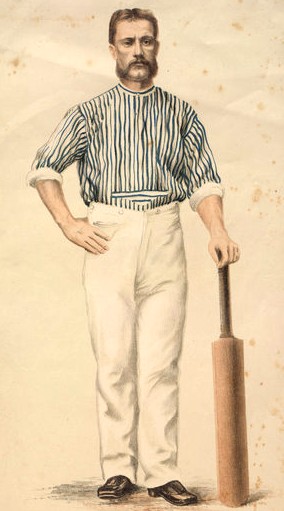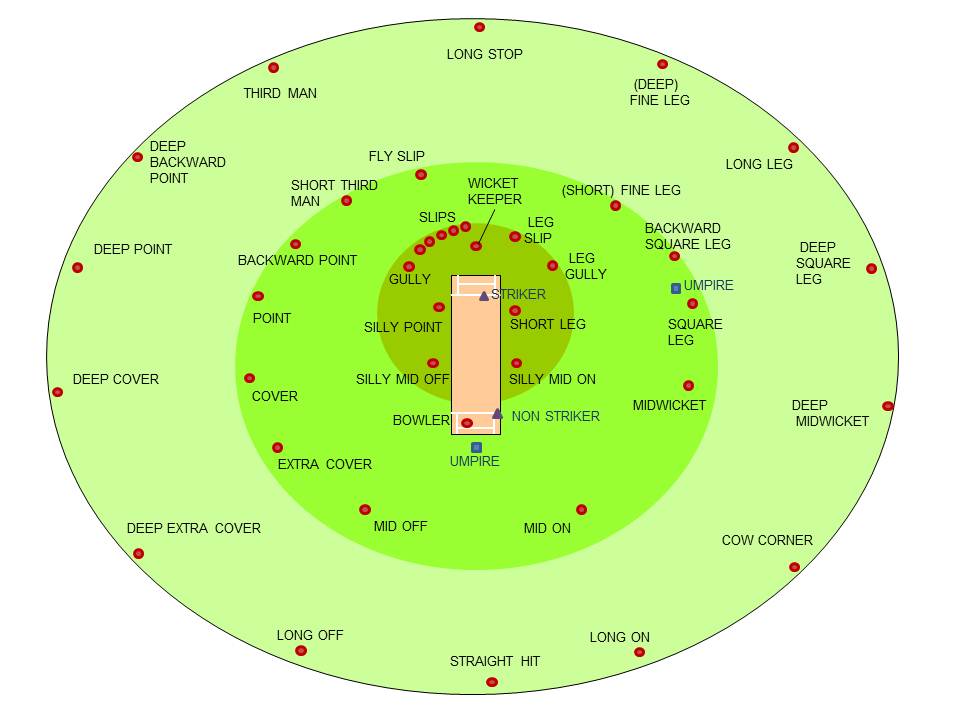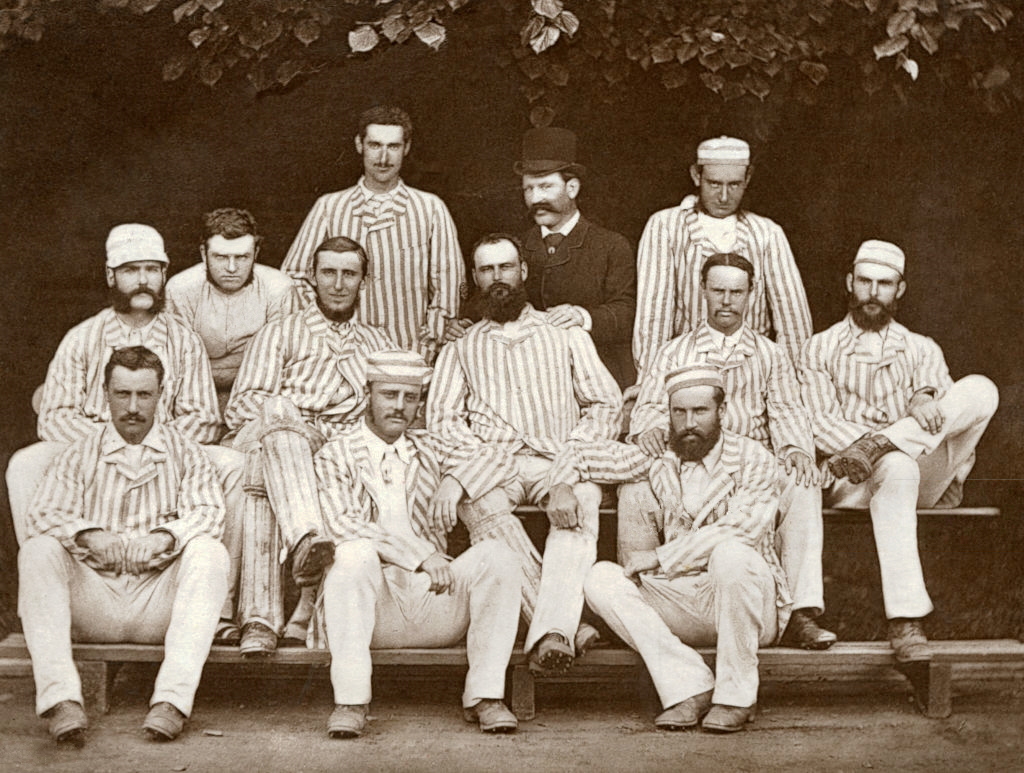|
Charles Bannerman
Charles Bannerman (3 July 1851 – 20 August 1930) was an English-born Australian cricketer. A right-handed batsman, he represented Australia in three Test matches between 1877 and 1879. At the domestic level, he played for the New South Wales cricket team. Later, he became an umpire. He is most famous for facing the first ball ever bowled in Test cricket, scoring the first run in Test cricket and making the first Test century. This innings of 165 remains the highest individual share of a completed team innings in Test cricket history, despite more than 2,000 Test matches being played since that first Test. Ironically in another first, he was forced to retire hurt; when a ball broke his finger. Early life Bannerman was born in Woolwich, Kent, England to William Bannerman and his wife Margaret. Not long afterwards the family migrated to New South Wales, Australia, where he joined the Warwick Cricket Club in Sydney. At the club he was trained by William Caffyn, a former Surrey ... [...More Info...] [...Related Items...] OR: [Wikipedia] [Google] [Baidu] |
Woolwich
Woolwich () is a district in southeast London, England, within the Royal Borough of Greenwich. The district's location on the River Thames led to its status as an important naval, military and industrial area; a role that was maintained throughout the 16th to 20th centuries. After several decades of economic hardship and social deprivation, the area now has several large-scale urban renewal projects. Geography Woolwich is situated from Charing Cross. It has a long frontage to the south bank of the Thames river. From the riverside it rises up quickly along the northern slopes of Shooter's Hill towards the common, at and the ancient London–Dover Road, at . The ancient parish of Woolwich, more or less the present-day wards Woolwich Riverside and Woolwich Common, comprises . This included North Woolwich, which is now part of the London Borough of Newham. The ancient parishes of Plumstead and Eltham became part of the civil parish of Woolwich in 1930. Parts of the wards ... [...More Info...] [...Related Items...] OR: [Wikipedia] [Google] [Baidu] |
Victoria Cricket Team
The Victoria men’s cricket team is an Australian first-class men's cricket team based in Melbourne, Victoria. The men’s team, which first played in 1851, represents the state of Victoria in the Marsh Sheffield Shield first-class competition and the Marsh One Day Cup 50-over competition. It was known as the Victorian Bushrangers between 1995 and 2018, before dropping the Bushrangers nickname and electing to be known as simply Victoria in all cricket competitions. Victoria shares home matches between the Melbourne Cricket Ground in East Melbourne and the Junction Oval in St Kilda. The team is administered by Cricket Victoria and draws its players primarily from Victoria's Premier Cricket competition along with players from throughout the country. Victoria also played in the now-defunct Twenty20 competition, the Twenty20 Big Bash, which was replaced by the franchise-based Big Bash League. The Victorian cricket team is the second-most successful state team in Australia ... [...More Info...] [...Related Items...] OR: [Wikipedia] [Google] [Baidu] |
Bob Crockett
Robert Maxwell Crockett (1863 in Hepburn, Victoria – 11 December 1935, at Footscray, Victoria), was an Australian Test match umpire. Crockett umpired a total of 32 Test matches, the highest number by an Australian umpire until passed by Tony Crafter in his last match in 1992. His first match was between Australia and England at Sydney on 12 December to 16 December 1901, a match which England won by an innings.. His colleague was Richard Callaway, also standing in his first Test match. Crockett was inspired to take up cricket umpiring at the age of 25 by the brave deeds of "Dimboola Jim" Phillips who waged war on the chuckers of the 1890s, bowlers who threw the ball instead of bowling it. For more than 20 years he was a regular Test umpire, and his first-class career lasted for 38 years. Known as the "Chief Justice" he was, in Jack Pollard's view, "a softly-spoken, imperturbable character … precise, unemotional, lacking in sentiment … He was a stickler for decoru ... [...More Info...] [...Related Items...] OR: [Wikipedia] [Google] [Baidu] |
Elisha Rawlinson
Elisha Barker Rawlinson (10 April 1837 – 17 February 1892) was an English first-class cricketer, who played one first-class match for Lancashire County Cricket Club in 1867, thirty seven for Yorkshire between 1867 and 1875, six for the United North of England Eleven from 1870 to 1874, plus one game for the North of England in 1875. He played non first-class cricket for Durham in 1884 and 1885. Born in Yeadon, near Leeds, Yorkshire, England, Rawlinson was a right-handed batsman, standing nearly five foot nine inches, who scored 1,120 runs at 15.34, with a best of 55 for Yorkshire against Nottinghamshire. He took 8 wickets at an average of 9.87, bowling right arm round arm fast, with a best analysis of 4 for 41 for Yorkshire against Gloucestershire. He took 23 catches, mainly at cover point. He emigrated to Australia, officiating one match between Australia and England in Sydney on 28 January to 31 January 1887; won by England by 13 runs after scoring a paltry 45 runs in ... [...More Info...] [...Related Items...] OR: [Wikipedia] [Google] [Baidu] |
Sydney Cricket Ground
The Sydney Cricket Ground (SCG) is a sports stadium in Sydney, Australia. It is used for Test cricket, Test, One Day International and Twenty20 cricket, as well as, Australian rules football and occasionally for rugby league, rugby union and association football. It is the home ground for the New South Wales cricket team, New South Wales Blues cricket team, the Sydney Sixers of the Big Bash League and the Sydney Swans of the Australian Football League. It is owned and operated by the Venues NSW, who also hold responsibility for the Sydney Football Stadium (2022), Sydney Football Stadium. History Beginning In 1811, the Governor of New South Wales, Lachlan Macquarie, established the second Sydney Common, about one-and-a-half miles (about 2,400m) wide and extending south from South Head Road (now Oxford Street, Sydney, Oxford St) to where Randwick Racecourse is today. Part sandhills, part swamp and situated on the south-eastern fringe of the city, it was used as a rubbish dump in ... [...More Info...] [...Related Items...] OR: [Wikipedia] [Google] [Baidu] |
Umpire (cricket)
In cricket, an umpire (from the Old French ''nompere'' meaning not a peer, i.e. not a member of one of the teams, impartial) is a person who has the authority to make decisions about events on the cricket field according to the ''Laws of Cricket''. Besides making decisions about legality of delivery, appeals for wickets and general conduct of the Game in a legal manner, the umpire also keeps a record of the deliveries and announces the completion of an over. A cricket umpire is not to be confused with the referee who usually presides only over international matches and makes no decisions affecting the outcome of the game. Overview Traditionally, cricket matches have two umpires on the field, one standing at the end where the bowler delivers the ball (bowler's end), and one directly opposite the facing batsman (usually, but not always, at square leg). However, in the modern game, there may be more than two umpires; for example Test Matches have four: two on-field umpires, a thi ... [...More Info...] [...Related Items...] OR: [Wikipedia] [Google] [Baidu] |
Australian Cricket Team In England And The United States In 1878
From May to September in 1878, an Australian cricket team made the inaugural first-class tour of England by a representative overseas side. In October, the Australians played additional matches in the USA and Canada on their return journey. The tour followed one made by an England team to Australia in 1876–77, during which the first matches retrospectively given Test match status were played. None of the 1878 matches had international status, nevertheless the tour proved to be such an outstanding financial and sporting success that the future of international cricket was assured. The Australian team was managed by John Conway and captained by Dave Gregory. William Gibbes, who was a non-player, acted as the team's assistant-manager and secretary. Conway was a journalist from Geelong, Victoria while Gregory and Gibbes were both Sydney-based accountants working for the New South Wales Public Service. These three cricket enthusiasts were the architects of the venture. They and ... [...More Info...] [...Related Items...] OR: [Wikipedia] [Google] [Baidu] |
Wicket-keeper
The wicket-keeper in the sport of cricket is the player on the fielding side who stands behind the wicket or stumps being watchful of the batsman and ready to take a catch, stump the batsman out and run out a batsman when occasion arises. The wicket-keeper is the only member of the fielding side permitted to wear gloves and external leg guards. The role of the keeper is governed by Law 27 of the Laws of Cricket. Stance Initially, during the bowling of the ball the wicket-keeper crouches in a full squatting position but partly stands up as the ball is received. Australian wicket-keeper Sammy Carter (1878 to 1948) was the first to squat on his haunches rather than bend over from the waist (stooping). Purposes The keeper's major function is to stop deliveries that pass the batsman (in order to prevent runs being scored as 'byes'), but he can also attempt to dismiss the batsman in various ways: * The most common dismissal effected by the keeper is for him to '' catch'' a ... [...More Info...] [...Related Items...] OR: [Wikipedia] [Google] [Baidu] |
Innings
An innings is one of the divisions of a cricket match during which one team takes its turn to bat. Innings also means the period in which an individual player bats (acts as either striker or nonstriker). Innings, in cricket, and rounders, is both singular and plural; this contrasts with baseball and softball in which the singular is "inning". Origin The earliest known record of the term concerns a match in August 1730 at Blackheath, Kent between a Kent side and London Cricket Club. The London-based ''St. James Evening Post'' reported: "'Twas thought that the Kentish champions would have lost their honours by being beat at one innings if time had permitted". Usage in cricket An innings is one of the divisions of a match during which one team takes its turn to bat, and is said to be "in to bat". Innings is the subject of Law 13 in the ''Laws of Cricket''. * In a first-class match, there are up to four innings with each team due to bat twice (in practice, this is not always the c ... [...More Info...] [...Related Items...] OR: [Wikipedia] [Google] [Baidu] |
George Ulyett
George Ulyett (21 October 1851 – 18 June 1898) was an English cricketer, noted particularly for his very aggressive batsmanship. A well-liked man (who, in later years, kept a pub in his native Sheffield), Ulyett was popularly known as "Happy Jack", once musing memorably that Yorkshire played him only for his good behaviour and his whistling. A fine all round sportsman, Ulyett played football in the 1882–83 and 1883–84 seasons as goalkeeper for Sheffield Wednesday. Cricket career Born in Pitsmoor, Sheffield, Ulyett joined the local Pitsmoor club at the age of sixteen and, from 1871 to 1873, played as a professional in Bradford. In 1873, he made his Yorkshire debut, at Bramall Lane against Sussex, and remained a valued member of the team for the next twenty years, passing 1,000 runs in ten seasons and fifty wickets in three. In his best batting year of 1883 Ulyett achieved the remarkable feat of scoring 1,562 runs – eleven runs from being the leading run scorer – w ... [...More Info...] [...Related Items...] OR: [Wikipedia] [Google] [Baidu] |
Alfred Shaw
Alfred Shaw (29 August 1842 – 16 January 1907) was an eminent Victorian cricketer and rugby footballer, who bowled the first ball in Test cricket and was the first to take five wickets in a Test innings (5/35). He made two trips to North America and four to Australia, captaining the English cricket team in four Test matches on the all-professional tour of Australia in 1881/82, where his side lost and drew two each. He was also, along with James Lillywhite and Arthur Shrewsbury, co-promoter of the tour. He also organised the first British Isles rugby tour to Australasia in 1888. Career Shaw was one of the few cricketers of his time whose Christian name was used more frequently than his initials. Standing only 5'6½" tall, he put on copious weight near the end of his career, when his naturally corpulent build was dramatically accentuated. It is unfortunate, therefore, that most photographs of him were taken so late in his cricketing life. A man of droopy aspect, bushed eyes, so ... [...More Info...] [...Related Items...] OR: [Wikipedia] [Google] [Baidu] |
Melbourne Cricket Ground
The Melbourne Cricket Ground (MCG), also known locally as "The 'G", is an Australian sports stadium located in Yarra Park, Melbourne, Victoria, Australia, Victoria. Founded and managed by the Melbourne Cricket Club, it is the largest stadium in the Southern Hemisphere, the List of stadiums by capacity, 11th largest globally, and List of cricket grounds by capacity, the second largest cricket ground by capacity. The MCG is within walking distance of the Melbourne City Centre, city centre and is served by Richmond railway station, Melbourne, Richmond and Jolimont railway station, Jolimont railway stations, as well as the Melbourne tram route 70, route 70, Melbourne tram route 75, route 75, and Melbourne tram route 48, route 48 trams. It is adjacent to Melbourne Park and is part of the Melbourne Sports and Entertainment Precinct. Since it was built in 1853, the MCG has undergone numerous renovations. It served as the centerpiece stadium of the 1956 Summer Olympics, the 2006 Com ... [...More Info...] [...Related Items...] OR: [Wikipedia] [Google] [Baidu] |


.jpg)



